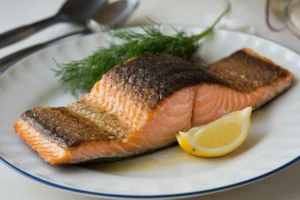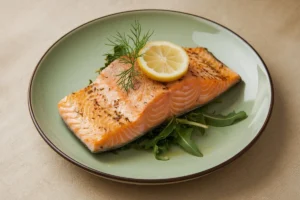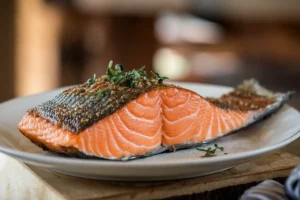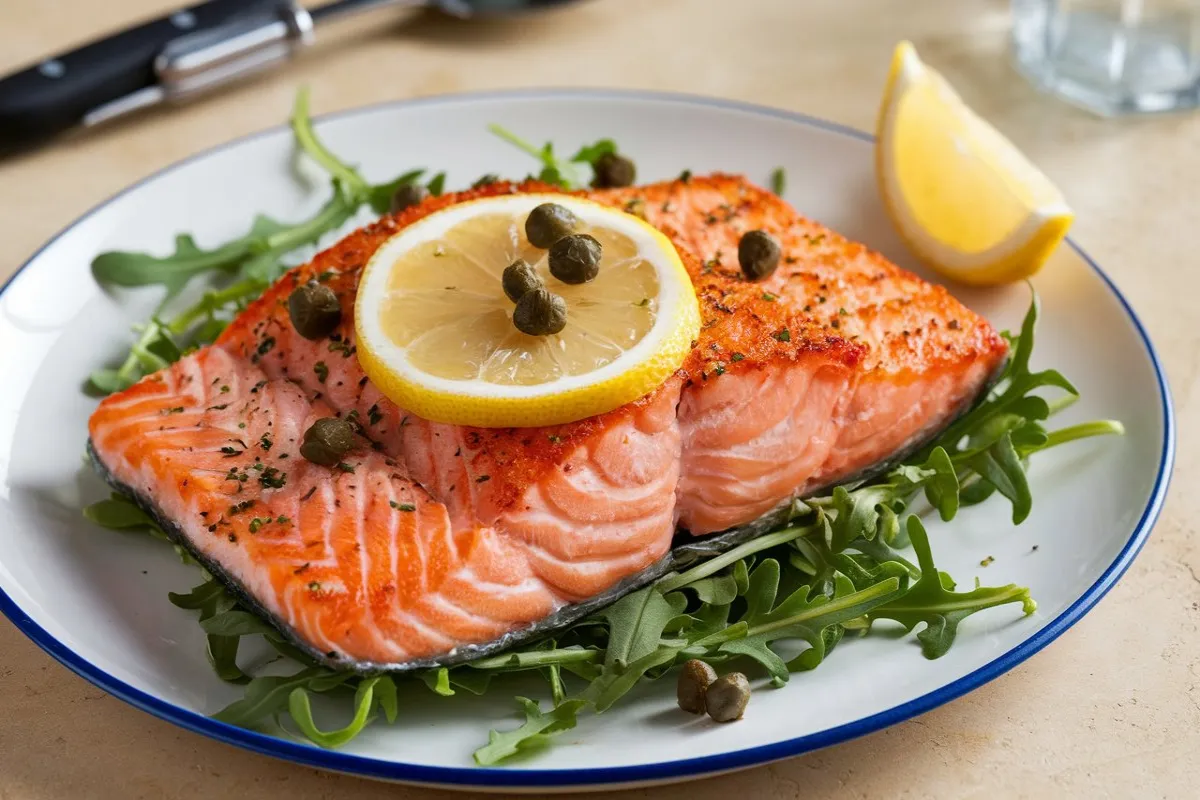How Long Should You Pan-Fry Salmon? A Complete Guide
Salmon is a beloved fish, rich in omega-3 fatty acids, and it makes for a nutritious, tasty meal. One of the most popular and effective methods of preparing salmon is pan-frying, but it can be tricky to get the timing just right. Too little time in the pan can leave your salmon raw, while overcooking can make it dry and tough. So, how long should you pan-fry salmon?
In this detailed guide, we’ll explore everything you need to know about pan-frying salmon, from selecting the right fillet to mastering the technique, along with tips, tricks, and FAQs to help you achieve perfectly cooked salmon every time.
Understanding the Basics of Pan-Frying Salmon
Before diving into the timing, it’s essential to understand why pan-frying is such a popular method for cooking salmon. When done correctly, it can create a crisp, flavorful crust on the outside while keeping the inside tender and juicy.
Why Pan-Frying?
Pan-frying allows you to cook salmon quickly while enhancing the natural flavors. It also creates a beautiful texture contrast between the crispy skin and the soft, flaky meat. This method is preferred by home cooks and chefs alike for its simplicity and the restaurant-quality results it delivers.
How Long to Pan-Fry Salmon: The Timing Sweet Spot
The golden rule for pan-frying salmon is to cook it for about 3 to 4 minutes per side over medium-high heat. The exact time depends on the thickness of your fillet, whether you are cooking with or without the skin, and your desired level of doneness.
Cooking with Skin-On
If your salmon fillet has the skin on, you’ll want to start by cooking it skin-side down. This helps the skin crisp up nicely and protects the flesh from drying out.
- For a fillet about 1-inch thick: Cook it for 4 minutes on the skin side and 3 minutes on the flesh side.
- Thicker fillets (more than 1 inch) may require 5 minutes on the skin side and 4 minutes on the flesh side.
Cooking Without Skin
For skinless salmon fillets, the cooking time is similar, but you’ll need to be extra mindful of the flesh as there’s no skin to act as a buffer.
- For a 1-inch thick fillet: Cook for 3 minutes per side over medium-high heat.
Key Factors That Influence Cooking Time

The exact amount of time you should pan-fry your salmon depends on several factors. Let’s look at these more closely to ensure you get the best possible result every time.
Thickness of the Fillet
One of the most significant factors is the thickness of your salmon fillet. A general rule of thumb is to cook the fish for 10 minutes per inch of thickness. For example, a fillet that is 1.5 inches thick may require a total of 12 to 15 minutes of cooking time (6 to 7 minutes per side).
Heat Level
The temperature of your pan also plays a crucial role. Cooking over medium-high heat allows the salmon to develop a crispy exterior without overcooking the interior. If the heat is too high, you risk burning the outside before the inside is done.
Type of Salmon
Different types of salmon have different fat contents, which can affect the cooking time. For example, wild salmon varieties like sockeye or coho are leaner and cook faster than farm-raised Atlantic salmon, which has a higher fat content.
The Perfect Pan for Frying Salmon
While timing is critical, using the right tools is equally important. The type of pan you use can affect how your salmon cooks, so choosing wisely can make a big difference in your results.
Choosing the Right Pan
A heavy-bottomed, non-stick skillet or cast-iron pan works best for pan-frying salmon. These pans distribute heat evenly and help create a crispy crust without sticking. Avoid using lightweight pans, which may not provide even heat distribution and could cause your salmon to cook unevenly.
Preparing Your Pan
Before adding your salmon, preheat the pan for about 3 minutes over medium-high heat. You want the pan to be hot enough that a drop of water sizzles and evaporates quickly. Once the pan is ready, add a small amount of oil—about 1 tablespoon of olive oil or avocado oil. These oils have a high smoke point, making them ideal for high-heat cooking.
Step-by-Step Guide to Pan-Frying Salmon
Now that you know the factors that affect cooking time, here’s a step-by-step guide to help you achieve perfectly pan-fried salmon every time.
Ingredients:
- 2 salmon fillets (skin-on or skinless)
- 1 tablespoon olive oil or avocado oil
- Salt and pepper to taste
- Optional: lemon wedges, fresh herbs (dill, parsley), garlic, butter
Instructions:
- Season the Salmon: Pat the salmon fillets dry with a paper towel to remove excess moisture. This step helps achieve a crispy sear. Season both sides generously with salt and pepper.
- Heat the Pan: Place your pan over medium-high heat and let it heat up for about 3 minutes. Add your oil and wait until it shimmers but isn’t smoking.
- Cook Skin-Side Down: If you’re using skin-on fillets, start by placing the salmon skin-side down in the pan. Press down on the fillet for a few seconds with a spatula to prevent the edges from curling up. Cook for 3-4 minutes.
- Flip and Finish: Carefully flip the salmon fillet and cook the flesh side for another 3-4 minutes. The salmon is done when it turns opaque and flakes easily with a fork.
- Rest the Salmon: Remove the salmon from the pan and let it rest for a minute or two before serving. This allows the juices to redistribute throughout the fish, ensuring every bite is moist and flavorful.
Common Mistakes to Avoid

Pan-frying salmon can be intimidating, especially if you’re new to cooking seafood. However, by avoiding these common mistakes, you can make sure your salmon turns out perfect every time.
Overcrowding the Pan
If you’re cooking multiple fillets, don’t overcrowd the pan. Doing so lowers the pan’s temperature, causing the salmon to steam rather than fry, which can result in soggy skin and uneven cooking. If necessary, cook the fillets in batches.
Cooking at Too High of a Temperature
While you want your pan to be hot, cooking at too high of a temperature can burn the outside of the salmon before the inside is done. Stick to medium-high heat for best results.
The Health Benefits of Salmon
Salmon is one of the most nutritious foods you can eat. It’s an excellent source of protein, omega-3 fatty acids, and vitamin D, making it a powerhouse for supporting heart health, brain function, and overall well-being.
Rich in Omega-3 Fatty Acids
Omega-3 fatty acids are essential for heart health. They help reduce inflammation, lower blood pressure, and improve cholesterol levels. Salmon is one of the best natural sources of omega-3s, particularly EPA and DHA, which are vital for brain function and reducing the risk of heart disease.
High in Protein
Each 3.5-ounce serving of salmon provides about 25 grams of protein, making it an excellent option for those looking to build muscle or maintain a healthy weight.
Loaded with Vitamins and Minerals
Salmon is also rich in vitamins B12, D, and selenium, all of which play important roles in keeping your body functioning properly. Vitamin D, in particular, is crucial for bone health and immune support, and many people don’t get enough of it from their diet.
Seasoning and Flavor Pairings for Pan-Fried Salmon
The beauty of salmon is that it’s incredibly versatile, pairing well with various seasonings and flavors. Whether you prefer a simple preparation or something a bit more adventurous, there are endless possibilities.
Simple Seasoning: Salt, Pepper, and Lemon
A classic combination of salt, pepper, and lemon is often all you need to enhance the natural flavors of salmon. After cooking, squeeze some fresh lemon juice over the fillets for brightness and add some chopped herbs like dill or parsley for freshness.
Asian-Inspired Flavors
For an Asian twist, you can marinate the salmon in a mix of soy sauce, ginger, garlic, and sesame oil before pan-frying. Serve with a drizzle of teriyaki sauce or a sprinkle of sesame seeds for a complete flavor profile.
Herb Butter Finish
Another option is to finish your salmon with a pat of herb-infused butter. You can make a simple compound butter by mixing softened butter with fresh herbs like parsley, chives, or tarragon. Adding a bit of garlic or lemon zest can take this butter to the next level.
Ideal Side Dishes to Serve with Pan-Fried Salmon
Now that you’ve mastered the art of pan-frying salmon, you may wonder what to serve alongside it. Here are some classic and creative ideas for side dishes that complement salmon beautifully.
Classic Sides
- Steamed Asparagus: The light and earthy flavor of asparagus pairs perfectly with rich salmon.
- Garlic Mashed Potatoes: For a heartier option, mashed potatoes with a touch of garlic butter provide a comforting contrast to the salmon’s crispy exterior.
Healthy Side Options
- Quinoa Salad: Quinoa is packed with protein and fiber, making it a healthy and delicious pairing with salmon.
- Roasted Brussels Sprouts: Roasting Brussels sprouts brings out their natural sweetness, which pairs wonderfully with the savory notes of pan-fried salmon.
Frequently Asked Questions (FAQs)

1. How do I know when my salmon is done?
Salmon is done when it turns opaque and flakes easily with a fork. If you’re unsure, use a meat thermometer to check the internal temperature. The FDA recommends cooking salmon to 145°F. However, some chefs prefer to cook it to 120°F for medium-rare.
2. Can I pan-fry frozen salmon?
Yes, you can pan-fry frozen salmon, but it’s best to thaw it first for even cooking. If cooking from frozen, you may need to extend the cooking time by a few minutes per side.
3. What oil should I use for pan-frying salmon?
It’s best to use oils with a high smoke point, such as olive oil, avocado oil, or grapeseed oil. These oils can handle the high heat needed for pan-frying without burning.
Conclusion: Mastering Pan-Fried Salmon
Pan-frying salmon is an art that, once mastered, can transform your home-cooked meals into restaurant-quality dishes. With the right timing, proper technique, and an understanding of how different factors—such as heat and fillet thickness—affect cooking, you’ll be able to serve perfectly cooked salmon every time.
Salmon’s health benefits and versatility make it a fantastic addition to any meal. Whether you enjoy it with simple seasoning or more adventurous flavors, How long should you pan-fry salmon is sure to become one of your go-to dishes. Experiment with different seasonings, sides, and techniques, and don’t be afraid to get creative in the kitchen.
By following the tips outlined in this guide, you’ll be well on your way to mastering the art of pan-frying salmon. Happy cooking!

